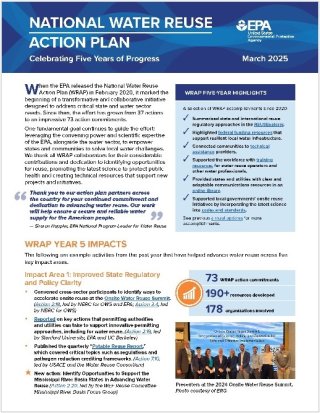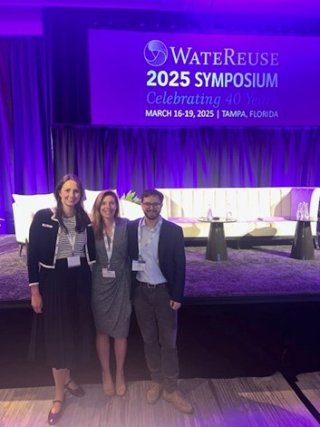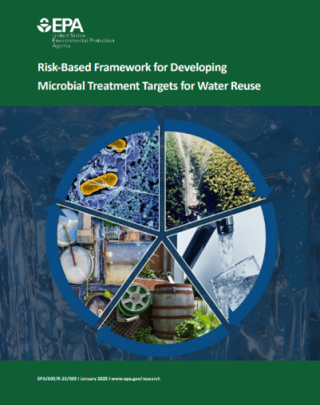Recent and Upcoming Water Reuse Activities
This page highlights recent or upcoming accomplishments and activities relevant to water reuse. Most items on this page are associated with the National Water Reuse Action Plan (WRAP), which is a coordinated and collaborative effort across the water community to advance consideration of reuse to ensure the security, sustainability, and resilience of our nation’s water resources.
Upcoming Reuse Activities and Events
- April 8-9—National Water Policy Fly-In, presented by the AWWA, AMWA, NACWA, WRF, WEF and WateReuse. Learn more here.
- April 30—EPA’s Creating the Water Workforce of the Future Webinar: Leading the Way Through Innovation and Collaboration. Register here.
- May 2—Deadline to apply for Current’s Great Lakes ReNEW Use-Inspired R&D and Translation Grant Program. Apply here.
- June 8-11—AWWA's 2025 Annual Conference & Expo. Learn more here.
- June 23-25—2025 Industrial Water Solutions Conference, hosted by WateReuse and WEF. Learn more here.
Publications and Events

The EPA Releases Fifth National Water Reuse Action Plan (WRAP) Annual Update. The 2025 “WRAP Update on Collaborative Progress” highlights recent accomplishments by action leaders and partners and celebrates five years of advancing water reuse. Congratulations to all WRAP collaborators on this milestone! (Action 10.3: Facilitate Implementation of the WRAP)
The ReWater Center Publishes Report on Pathogen Reduction Crediting for Reverse Osmosis. The newest issue of the Potable Water Reuse Report analyzes pathogen crediting frameworks for RO. Crediting frameworks ensure that treatment systems effectively remove pathogens, but, as the report explains, current frameworks may under-credit RO as a pathogen barrier. To address this issue, the report highlights research needs and alternative approaches to enhance RO crediting. Sign up to receive these reports! (Action 7.10: Implement the DoD-funded Water Reuse Consortium for Water Resiliency at Military and Municipal Facilities)
The Building Infrastructure Locally for Decentralized Water Systems (BILD) Initiative Launched. The BILD initiative, put forward by the National Blue Ribbon Commission for Onsite Water Systems, builds cross-sector coalitions to expand decentralized water systems. BILD is a collaborative global community of practice working to uncover opportunities, advance implementation and spread transformative solutions related to decentralized water systems to support the efficient use and reuse of water. BILD held its first kick-off meeting on March 5th, and teams will be meeting regularly to develop roadmaps to focus on advancing projects across four impact areas: public health, sustainable technology / innovation, capacity development and communications. Please reach out to Taylor Nokhoudian for more information and to learn how to participate in this initiative. (Action 3.4: Develop Research and Tools to Support Onsite Water Systems)
Celebrating 5 Years of WRAP Progress at the 2025 WateReuse Symposium!

Many WRAP collaborators gathered at the WateReuse Symposium in Tampa to lead and attend technical sessions and workshops. Among these events was the 5th State Summit on Water Reuse. During the closed-door session, the EPA, ACWA, ASDWA, ASTHO and GWPC convened state regulators from 20 states to exchange ideas and discuss lessons learned across a variety of water reuse topics. Additionally, at a special session celebrating the fifth anniversary of the WRAP, the EPA’s National Program Leader for Water Reuse, Sharon Nappier, released the annual progress update and spotlighted action leader achievements.
Other sessions that featured WRAP actions, collaborators and resources include:
- Understanding NSF/ANSI 350 and How It Enables Onsite Reuse (Action 2.18: Incorporate Onsite Reuse Research into Codes and Standards for Premise Plumbing)
- Risk-Based Treatment Targets for Water Reuse: State of the Science (Action 3.1: Compile Existing Fit-for-Purpose Specifications)
- Harnessing Collective Action to Advance Thriving Communities through Water Reuse (Action 5.5: Quantify the National Potential for Reuse)
- Implementing a National Research Priority Navigator for Water Reuse (Action 7.2: Develop a Coordinated National Research Strategy)
- Water Reuse Consortium; Flowing Forward: From Mountaintop to Metropolis, Chasing LA’s Water; Advancing Direct Potable Reuse Worldwide: The Impact of Regulations on Implementation; Pathogen Reduction Crediting: It’s not what you can remove, it's what you can prove! (Action 7.10: Implement the Water Reuse Consortium)
- Engaging Medical Professionals (Action 8.8: Engage the Medical Community on Risks and Benefits of Water Reuse)

Risk-Based Framework for Developing Microbial Treatment Targets for Water Reuse

This 2025 publication provides detailed scientific information that state regulators can use to develop their own risk assessments and microbial treatment targets that support safe potable and non-potable water reuse. Alongside its analysis, the document presents the latest science on pathogen concentrations and treatment targets in common source waters for reuse, including stormwater and municipal wastewater, which eliminates the long and costly step of source water characterization for local reuse projects. This comprehensive framework will enable states to quickly permit alternative source waters, bolstering the spirit of cooperative federalism while ensuring that water reuse treatment decisions reflect the most current science. (Action 3.1: Compile Existing Fit-for-Purpose Specifications)
Water Reuse Funding
Apply to the Great Lakes ReNEW Use-Inspired Research & Development and Translation Grant Program. Current’s new competitive funding opportunity invites applicants to advance innovation in water reuse, wastewater treatment and resource recovery technologies. Projects may focus on a range of wastewater sources, including streams from data centers, agriculture, mining and more. Concept papers must be submitted by May 2, 2025, at 11:59 p.m. (CT).
Regulatory Update
The EPA Will Revise Wastewater Regulations for Oil and Gas Extraction to Help Unleash American Energy. The EPA announced that it will modernize outdated regulations on wastewater discharges for oil and gas extraction facilities to lower energy costs while supporting environmentally sustainable water reuse. This review will evaluate modern technologies and management strategies to provide regulatory flexibility for produced water to be treated for beneficial reuse, including for Artificial Intelligence and data center cooling, rangeland irrigation, fire control, power generation and ecological needs.
State Updates
Arizona Approves Advanced Water Purification (AWP) Rules. Following approval by the Governor’s Regulatory Review Council, Arizona’s AWP rule became effective on March 5. This rule establishes an adaptable regulatory program for approving direct potable reuse projects, providing a new water management tool to Arizona’s communities while safeguarding public health. In a region challenged by drought and rising demand, AWP represents a crucial method for developing reliable water supplies. Arizona is now the fourth state to pass a rule specific to direct potable reuse. The final rule is expected to be published later this spring.
Texas Breaks Ground on First Direct-to-Distribution Water Reuse Facility in the United States. El Paso Water began construction on a new advanced water purification facility capable of producing up to 10 million gallons of recycled water per day. The Pure Water Center will introduce recycled water directly into the city’s drinking water distribution system, marking a milestone as the nation’s first direct-to-distribution water reuse facility. Expected to open in late 2027, the facility will enhance the reliability of El Paso’s drinking water supplies.
Colorado Announces Regulations to Increase Produced Water Reuse within the Oil and Gas Industry. Colorado’s Energy and Carbon Management Commission adopted new rules to boost produced water reuse in oil and gas operations. The new regulation sets minimum benchmarks for produced water reuse, requiring all oil and gas operations to incorporate at least 4% recycled produced water into their activities by 2026. These efforts will help relieve pressure on the state’s freshwater resources.
Looking for something?
This page is updated frequently. If you’re looking for previously posted content that is no longer here (e.g., a past webinar, published report), you may be able to find it in our Water Reuse Information Library or Curated Topical Reuse Resources page. The latest entry on the Topical Resources page spotlights onsite non-potable reuse.
Links to websites outside of the EPA website are provided for the convenience of the user. Inclusion of information about a website, an organization, a product, or a service does not represent endorsement or approval by EPA, nor does it represent EPA opinion, policy or guidance unless specifically indicated. EPA does not exercise any editorial control over the information that may be found at any non-EPA website.
